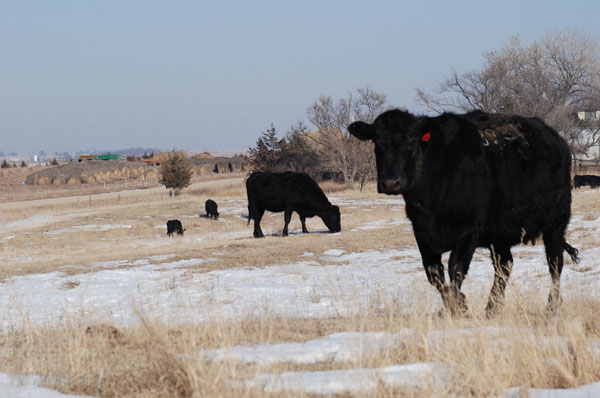Winter Prep Essential For Beef Cowherd Management
For each 10-degree temperature drop in wind chill below 30 degrees Fahrenheit, the energy requirement of a cow goes up by 13 percent in animals with moderate body conditions and dry winter hair coats.
December 14, 2012

The arrival of cold weather across the eastern Corn Belt means cattle producers need to take extra care in managing their livestock.
There are a number of techniques producers can employ to help animals maintain rate of gain and to protect cows as they approach the spring calving season.
First, feeding high-forage diets or forages with supplements can help cattle deal with cold-induced energy loss, said Ron Lemenager, Purdue Extension beef specialist. Because cattle are ruminants, digestion happens through a complex fermentation process that produces heat and energy.
Beyond diet modifications, producers also should be aware of how animals react to winter weather elements.
"A cow can handle zero or below-zero temperatures. It's the wet and windy conditions that can be tough," Lemenager said.
Animals with wet hides often can't create enough body heat to stay warm when it's windy. Lemenager recommended that producers create windbreaks for their animals to eliminate the wind chill.
For each 10-degree temperature drop in wind chill below 30 degrees Fahrenheit, the energy requirement of a cow goes up by 13 percent in animals with moderate body conditions and dry winter hair coats. If a cow is wet or thin, the energy requirement goes up by 30 percent for each 10-degree drop.
"For example, in a thin cow at zero degrees wind chill, the cow's energy requirement has increased 90 percent," Lemenager said. "She needs additional energy and protein, such as corn or distiller's grains."
A Closer Look: Winter Cow Management Starts Well Before Winter
But Lemenager cautioned farmers not to overfeed protein to late-pregnancy cows because there's an associated risk of increased calf birth weights and dystocia, or birthing difficulties.
"If we have a really cold winter, that will increase birth weights, anyway, because of the natural way a cow responds to cold," he said. "They reduce blood flow to extremities and increase flow inside, where the calf is growing. If it's cold and you're increasing protein too much, that will collectively bring up birth weights and birthing problems."
Another management tip is to ensure that herds have easy access to water throughout winter months.
"If animals don't drink water, they don't eat," Lemenager said. "Producers should frost-proof their water supplies, either by using tank heaters or chipping ice in ponds. We often forget about reviewing our water sources, but now's a good time to double-check those tank heaters before we get into the blistering cold of winter."
Producers who plan to allow animals to graze during the winter also should consider pasture management.
Pastures need to retain a stubble height of at least 4 inches, unless they will be reseeded in the spring.
"If you're in an area where wintering cows on pasture is feasible, create a sacrifice area for tromping so cows don't tromp all your acreage and damage chances for regrowth next season," Lemenager said. "Designating one area saves a whole pasture from being abused, and it's much cheaper than having to re-do an entire pasture."
In these sacrifice lots, Lemenager recommended that farmers disk or drill summer annuals or legumes that are suited to their areas next spring. This will allow an opportunity to make hay or provide additional grazing.
For those pastures that need renovation, allowing cattle to graze the pasture to a 2-inch stubble height will reduce the residue and allow for good seed-to-soil contact next spring and reduce the competition for new seedling to get established.
You May Also Like


.png?width=300&auto=webp&quality=80&disable=upscale)
